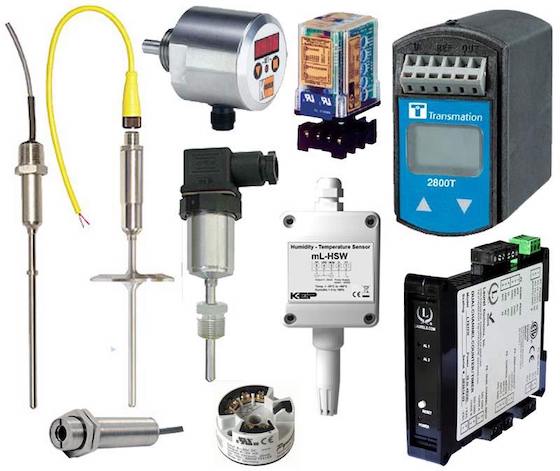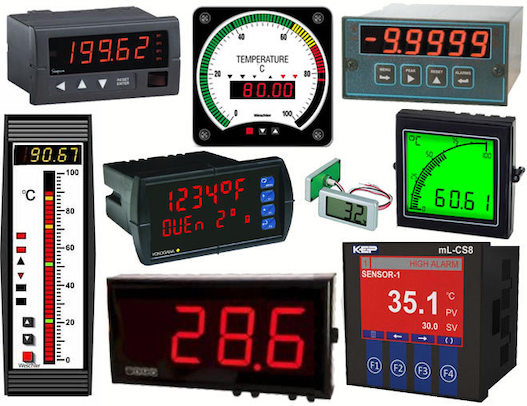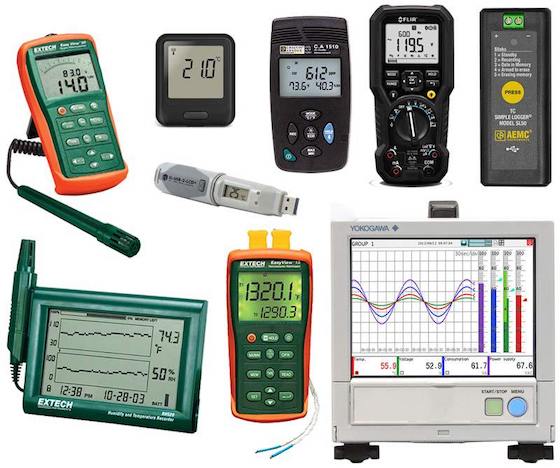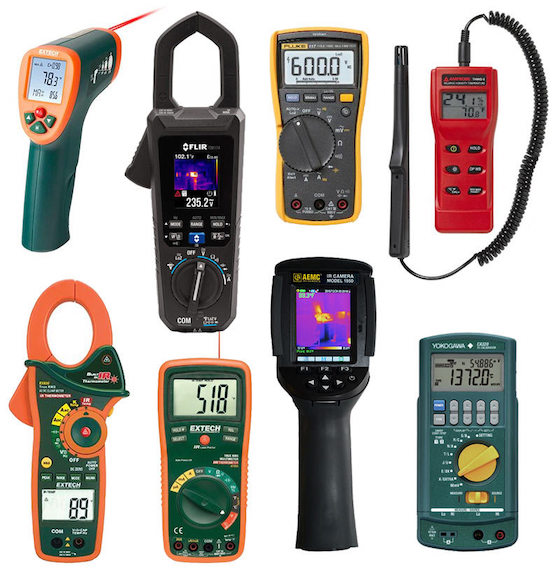The Weschler Temperature Measurement application note reviews the characteristics of popular sensors used to measure temperature: thermocouple, RTD (resistance temperature detector), thermistor, semiconductor, and infrared. This article surveys the instrumentation used in conjunction with these sensors for industrial temperature measurements.
In general, thermocouple instruments convert the microvolt signal generated by a thermocouple into a linear temperature signal that can be transmitted, displayed or used for control. The instrument accuracy specifies the precision of the voltage measurement and how closely the instrument follows the industry-standard conversion tables/equations for a particular thermocouple type.
RTD compatible instruments convert sensor resistance measurement into a temperature, also using industry-standard conversion tables/equations. To make the resistance measurement, the instrument supplies a small current to the RTD, either from a current source, bridge circuit or voltage divider.
For both thermocouples and RTDs, the types and characteristics are set by national standards, so the sensor and instrument can be purchased separately. A thermistor also requires a resistance measurement. However, thermistor characteristics are not standardized. A thermistor and instrument may be supplied together to overcome this obstacle or the thermistor mounted inside the instrument (e.g. for measurement of ambient temperature). For an external sensor, some instruments allow the user to enter an ohms to temperature conversion table that matches a particular thermistor. Due to this complication and other performance limitations, thermistors are not widely used in industrial applications.
Despite a well-defined junction voltage vs. temperature, semiconductors are also not generally used as stand-alone industrial temperature sensors. A silicon sensing element may be supplied with an instrument for a specific application, such as monitoring water temperature. Semiconductors are also a convenient solution for measuring the temperature inside an instrument (e.g. for thermocouple cold junction compensation).
For some industrial applications, infrared sensors are the preferred solution since they require no physical contact to make a temperature measurement. While not as accurate as contact sensors, their convenience and safety are attractive for both fixed and portable measurements.
A wide variety of instruments are available for temperature monitoring. Four major categories are transmitters, panel meters, recorders and handheld testers.
Transmitters convert a temperature into a standard electrical signal for local monitoring or transmission to a remote location. Note that manufacturers’ literature may refer to these devices as sensors or transducers. Some transmitters have an integral sensor; some connect to an industry-standard sensor, usually an RTD or thermocouple. The transmitter output is typically a process signal. Common output ranges are 0-5V, 0-10V, 0-1mA, and 4-20mA. In addition to a signal output, a transmitter may have a temperature display to aid setup and troubleshooting. Some transmitters may include a switch closure for alarm or control of an external process. Factors to consider in the selection of a temperature transmitter include the physical environment, temperature range to be measured, type of sensor, mechanical requirements of the installation, output signal, and available power.
 This temperature transmitter grouping shows a variety of packages. Moving clockwise from the upper left: two sheathed RTD transmitters, transmitter with integral silicon sensor and LED readout, plug-in T/C transmitter, stand-alone T/C & RTD transmitter with LCD readout, DIN-rail temperature transmitter, ambient monitor, ‘hockey-puck’ transducer, transmitter with immersible RTD sensor, and infrared sensor.
This temperature transmitter grouping shows a variety of packages. Moving clockwise from the upper left: two sheathed RTD transmitters, transmitter with integral silicon sensor and LED readout, plug-in T/C transmitter, stand-alone T/C & RTD transmitter with LCD readout, DIN-rail temperature transmitter, ambient monitor, ‘hockey-puck’ transducer, transmitter with immersible RTD sensor, and infrared sensor.
Panel meters house temperature measuring circuitry in a case suitable for mounting in a control panel. Today almost all temperature meters are electronic, with a digital readout. Most temperature meters measure an external sensor with 3, 4, or 5 digit resolution. Common display types are LED, LCD, bargraph and graphical. Popular case sizes are 1/4DIN and ANSI switchboard. Smaller models fit crowded panels. Large 12” units are suitable for viewing at long distances. Many temperature meters include analog output capability for remote monitoring and digital or relay outputs for control. Temperature controllers are panel meters with outputs and additional functions, such as PID control. Many factors go into the selection of a temperature meter. A few key criteria are sensor compatibility, display resolution, case size, available power, digital communication and type of output. Temperature meter selection tools often help narrow the available choices.
 This panel meter grouping shows – Top row: 4.5 digit DIN meter (T/C or RTD input), tri-color bargraph meter in 4.25” ANSI case (T/C or RTD), 5.5 digit DIN meter (T/C & RTD).
This panel meter grouping shows – Top row: 4.5 digit DIN meter (T/C or RTD input), tri-color bargraph meter in 4.25” ANSI case (T/C or RTD), 5.5 digit DIN meter (T/C & RTD).
Middle row: tri-color bargraph meter in 6” switchboard case (T/C or RTD), dual display meter (T/C or RTD), small surface mount meter (thermistor), 4 digit DIN meter with graphic display (T/C). Bottom row: Large display meter (T/C & RTD), 8 channel scanner (RTD).
Recorders measure temperature over a period of time and save the readings for future reference. This category includes data loggers, where data is saved in a digital format. A local readout, either digital or graphical, may be included. Most recorders are portable units with data saved internally for later transfer to a computer. Ambient recorders often include a temperature sensor. Other recorders typically connect to an external thermocouple or RTD. Important characteristics for a recorder include sensor compatibility, sample rate, memory size, and battery life. The method for data export is also significant. Some common means are USB or RS-232 serial interface, wireless via Bluetooth or wi-fi, and removable memory card.
 Shown here are (clockwise): a hygro-thermometer, wi-fi logger, air quality logger, temperature logging DMM, simple single-channel logger (no display), multi-channel chart recorder, 2 channel logging thermocouple meter, temperature/RH chart recorder, USB data logging stick.
Shown here are (clockwise): a hygro-thermometer, wi-fi logger, air quality logger, temperature logging DMM, simple single-channel logger (no display), multi-channel chart recorder, 2 channel logging thermocouple meter, temperature/RH chart recorder, USB data logging stick.
Handheld testers include dedicated temperature measuring instruments and multi-function units that have temperature capability along with other functions. The most popular single-function instruments are infrared thermometers and thermal cameras. Many DMMs now include a type K thermocouple input, which eliminates the need to carry a separate contact temperature meter. Some models offer two temperature channels for easy measurement of temperature difference. Recently manufacturers have incorporated contact and non-contact temperature capability into clamp multimeters, which are also a popular service tool. Portable calibrators are another category of handheld tester that includes temperature measurement. Single function calibrators handle either T/C or RTD sensors. Multifunction calibrators typically measure both types.
 This test equipment grouping shows (clockwise): an infrared thermometer, thermal imaging clamp multimeter, DMM with thermocouple input, psychrometer, temperature calibrator, thermal camera, DMM with IR thermometer, clamp meter with IR and thermocouple temperature functions.
This test equipment grouping shows (clockwise): an infrared thermometer, thermal imaging clamp multimeter, DMM with thermocouple input, psychrometer, temperature calibrator, thermal camera, DMM with IR thermometer, clamp meter with IR and thermocouple temperature functions.
Temperature is the most commonly measured physical parameter. Many different types of temperature measuring devices exist for this function. The specific requirements of the application will determine the best approach and the best equipment for each installation.
